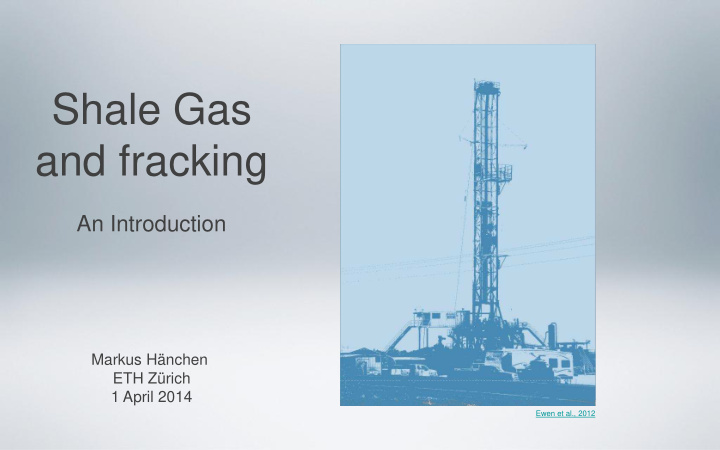



Shale Gas and fracking An Introduction Markus Hänchen ETH Zürich 1 April 2014 Ewen et al., 2012
U.S. Shale Gas Production 39% of total natural gas production in 2013 U.S. EIA, 2012
Formation of Fossil Fuels • Burial of organic material • First: biogenic methane production • Thermogenic oil and gas production • Oil and gas window Seewald, 2003
Unconventional Natural Gas • Upward migration from source rock • Conventional gas: Accumulation under structural traps • Tight gas: Trapped in low permeability rock • Shale gas: Remains trapped U.S. EIA, 2010 in source rock
Why We Need Fracking King, 2012 Permeability in millidarcy Pierce (USGS), 2012 Thin section photograph of shales -- small, unconnected pores
Hydraulic Fracturing • Pumping large volumes of water with sand and additives • 10 m 3 /min, 500 bar, 10’000 m 3 /well • Sand prevents closure of fractures after pressure reduction • 5 to 80% returns mixed with highly saline Marathon Oil, 2012 formation water (incl. heavy metals, NORM)
Well Construction • Multiple concentric steel casings encased with cement • Typically four casings with three casings in the freshwater layer • Depths of 1000 to 4000 m, lateral length of 1 to 3 km Ewen et al., 2012 BP, 2012
Well Layout • Multiple wells (up to 30+) drilled from one well pad • One pad can cover an area of 3x3 km or larger Ewen et al., 2012
Frac Fluids (1) Modify fluid properties • • • • • (2) Prevent undesirable reactions • • • • • fracfocus.org, August 2012 (3) pH adjustment
Frac Fluids (1) Modify fluid properties • Friction reducer • Gellant • Crosslinker • Breaker Frac Fluids rarely • Surfactant contain (2) Prevent undesirable reactions components from • Biocide all additive groups • Corrosion inhibitor • Anti-scaling agent • Clay stabiliser • Iron control (3) pH adjustment • Strong acids, bases, buffers
Examples of common additives (1) Modify fluid properties • Friction reducer > Polyacrylamide • Gellant > Guar Gum • Crosslinker > Sodium Perborate • Breaker > Sodium Peroxidisulphate, Cellulase • Surfactant > Nonyl Phenol Ethoxylate (2) Prevent undesirable reactions • Biocide > Glutaraldehyde • Corrosion inhibitor > Isopropanol • Anti-scaling agent > Ammonium Chloride • Clay stabiliser > Potassium Chloride • Iron control > Citric Acid (3) pH adjustment • Strong acids, bases, buffers > Hydrochloric Acid, Acetic acid
Frac Fluid Developments • The most toxic additives have been • (Full) disclosure > fracfocus.org (since 2011) phased out (benzene, diesel, fluorocarbons) • One operator: shortlist of nine chemicals only • Biocides replaced with UV, ozone, chlorine dioxide (drinking water purification) • Possible: Only using food additives since • Water-free fracs: Propane, N 2 , CO 2 2011 fracfocus.org, April 2014
Fracturing Monitoring • Pressure-flow rate response • Microseismic • Tiltmeter Zoback, 2010
What Can Be Problematic • Methane in groundwater (more sampling) • Surface or near surface spills of frac fluid or backflow (reduce toxicity of additives, stricter procedures) • Migration from deep underground (very unlikely) • Disposal of backflow (mostly re-injected, increased recycling) • Methane emissions during well completion (technically solvable: Green Completions, required in the US now) • Freshwater needs (only in arid areas) • Induced seismicity (mainly from backflow re-injection) • Land use, noise, light (mainly in undisturbed nature)
Recommend
More recommend